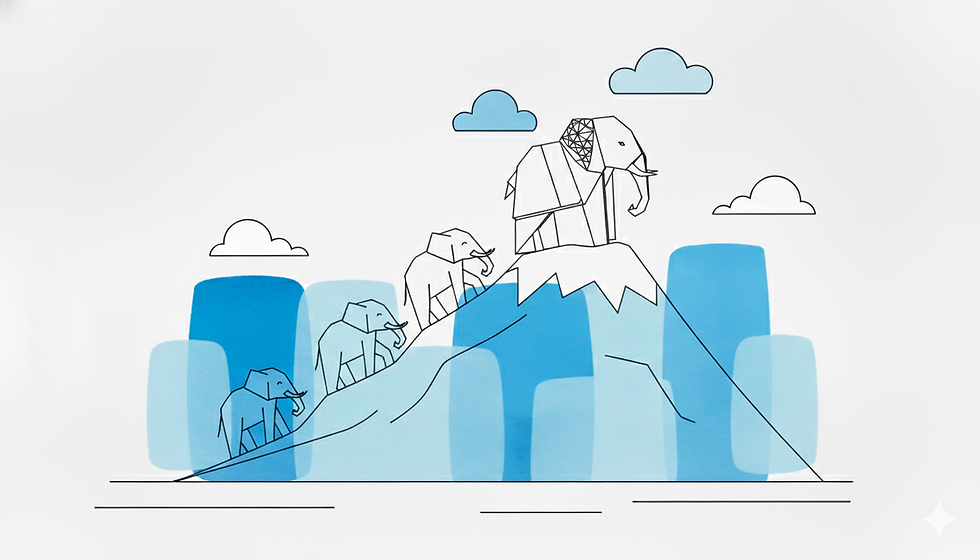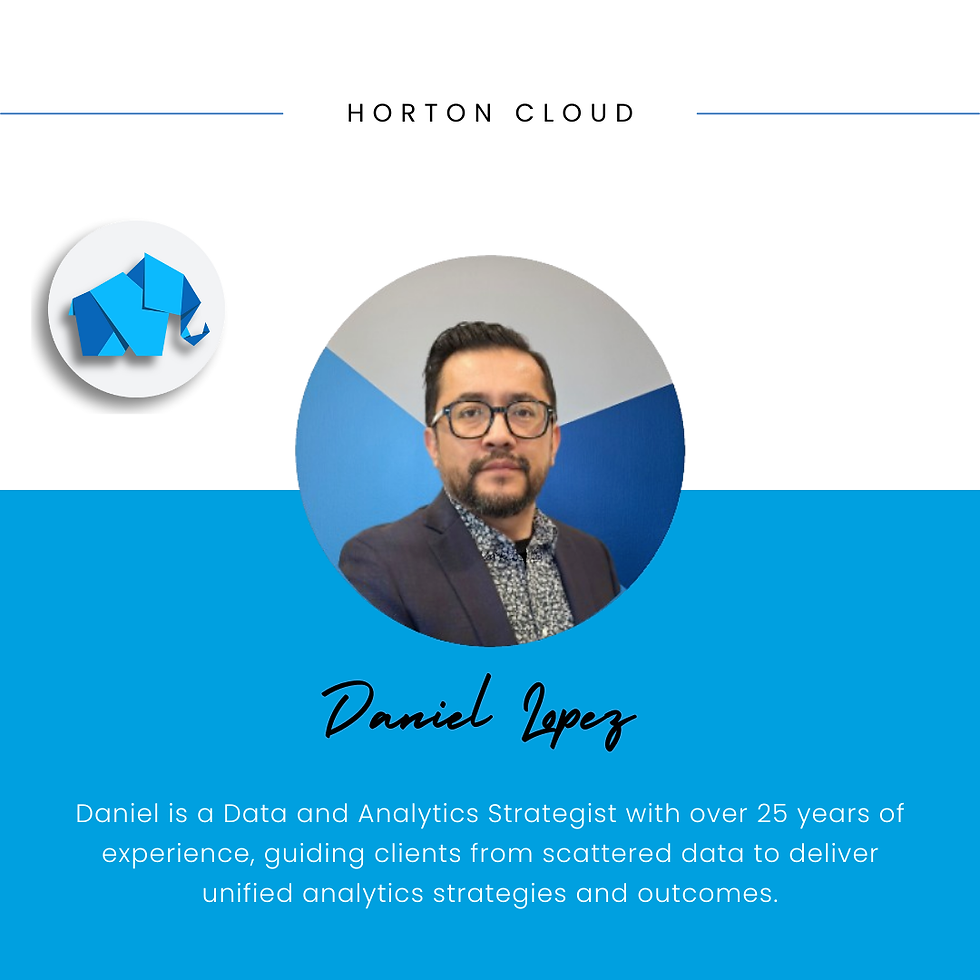Your Data Journey Continues: Preparation
- Daniel Lopez

- Oct 8
- 8 min read
Part 2: How Organizations Transform Raw Data into Strategic Resources In our opening exploration of the data journey, we compared your organization's data ecosystem to a vast river system with multiple tributaries flowing together to create a powerful current of business intelligence. We examined how the Collection phase establishes the critical intake channels, determining what information enters your ecosystem, when it arrives, and in what condition. Like carefully positioned collectors gathering water from mountain streams, your collection systems capture the raw potential that will eventually power your entire organization.
But collection alone doesn't create value. Those individual streams, such as customer transactions from your e-commerce platform, sensor readings from your manufacturing floor, social media interactions from your marketing channels, etc., remain isolated tributaries until they converge. This brings us to the crucial second phase of your data journey:
Preparation
The preparation phase transforms your collected data from scattered streams into strategic reservoirs. It's where convergence happens, where separate flows merge, mingle, and combine to create something far more powerful than their individual parts. Just as a well-engineered reservoir system doesn't simply store water but manages it for optimal distribution and use, your data preparation strategy doesn't just house information, it organizes, structures, and positions it for maximum potential business impact.

In this installment, we'll explore how modern organizations create these strategic data reservoirs through sophisticated storage architectures. You'll discover why the convergence points in your data ecosystem, where previously isolated information streams combine, often become the birthplace of your most valuable insights. Most importantly, you'll learn how to choose the right preparation approach for your specific business needs, balancing cost, performance, accessibility, and future flexibility. The Business Imperative of Strategic Preparation
Every insight that drives competitive advantage, every dashboard that guides executive decisions, every predictive model that anticipates market shifts all depend on how well you've collected and prepared your data for use. T he preparation phase establishes the foundation for analytics, determining not just what information is available, but how quickly teams can access it, how easily they can combine different data sources, and how confidently they can trust what they find.
Consider what happens when preparation is done well:
Data scientists spend time building models instead of hunting for clean data
Business analysts combine information from multiple systems efficiently
Executives trust the numbers in their dashboards
Operational teams access the information they need without bottlenecks
Conversely, poor preparation creates compounding problems:
Duplicate data storage inflates costs while confusing users
Inconsistent formats prevent meaningful cross-system analysis
Unclear data lineage erodes trust in critical metrics
Performance issues delay time-sensitive decisions
The way you prepare and organize your converged data directly affects your organization's ability to compete in a data-driven economy. It's the difference between having information and being able to use it effectively. Strategic Storage: Engineering Your Data Architecture
Modern data storage has evolved far beyond simple file systems or basic databases. Today's organizations face an array of sophisticated options, each designed to handle specific types of data and use cases. Understanding these options, and more importantly, understanding how they work together, is crucial for building a preparation strategy that serves your current needs while enabling future growth.
Let's explore the four primary approaches that form the backbone of modern data preparation:
Operational Data Stores: Retention Ponds
Like retention ponds that temporarily hold flowing water to monitor current conditions and help control downstream flooding, ODS systems capture your organization's real-time operational flow. Water stays just long enough to assess what's happening now before continuing its journey, providing immediate visibility without long-term storage.
When They Excel:
Customer service needing instant order status across systems
Supply chain operations tracking real-time inventory levels
System monitoring correlating performance across platforms
Operational dashboards displaying current KPIs and alerts
Fraud detection requiring immediate transaction visibility
The Practical Benefit: Lower investment than full warehouses while delivering immediate operational value. Bridges the gap between source systems and analytical platforms, ensuring teams can act on current information without waiting for batch processing.
Data Warehouses: Water Bottling Facilities
Think of a modern water bottling facility, where raw water is purified, tested, and packaged into clearly labeled and consistently sized bottles ready for immediate consumption. Every bottle meets exact quality standards, with labels showing source, contents, and certifications. This is your data warehouse: transforming raw information into standardized, trusted packages that the business can consume effectively and with confidence.
When They Excel:
Executive dashboards requiring consistent, reliable metrics
Regulatory compliance where accuracy and audit trails are non-negotiable
Financial reporting with zero tolerance for errors
Cross-functional analytics combining sales, operations, and customer data
Historical trend analysis examining patterns across time
The Investment Consideration: Higher upfront costs for data modeling and processing, but exceptional ROI for core business intelligence. Like bottling facilities, the infrastructure investment pays off through consistent quality and user trust.
Data Lakes: Massive Reservoirs
Picture a vast reservoir collecting water from an entire watershed, accepting everything in its natural state for future use. Rivers, rainfall, runoff all flow in without processing. Some water might eventually be bottled, some used for irrigation, some for industrial purposes. Data lakes embrace this same philosophy: store everything now, decide how to use it later.
When They Excel:
IoT initiatives collecting millions of sensor readings
Digital transformation aggregating logs, clicks, and social data
AI/ML programs requiring vast amounts of training data
Content repositories storing documents, images, and media
Future-proofing when you don't yet know how data will be used
Cost-effective archives preserving historical data
The Scale Advantage: Modern object storage offers virtually unlimited capacity at a fraction of traditional costs. Combined with distributed processing, lakes handle massive datasets that would overwhelm traditional systems.
Data Lakehouses: Smart Water Facilities
Imagine a modern facility that combines a massive reservoir with a bottling plant. Raw water can be stored indefinitely or purified and bottled on demand. Intelligent systems decide the optimal approach based on current needs, eliminating the inefficiency of separate facilities. This is the lakehouse promise: unified infrastructure that handles both raw storage and refined delivery.
When They Excel:
Modern analytics combining traditional BI with data science
Real-time analytics on streaming data without separate systems
Cost optimization eliminating redundant storage and processing
Unified governance applying consistent policies everywhere
Architecture modernization gradual migration from legacy systems
The Strategic Advantage: One platform supporting everything from executive dashboards to machine learning models. Reduces complexity, improves governance, and positions organizations for whatever comes next in the data evolution. Implementing Your Preparation Strategy
Understanding storage options is just the beginning. Successful preparation requires thoughtful implementation that considers your organization's unique needs, constraints, and aspirations. Here's how to approach building your data preparation infrastructure:
Start with Business Outcomes Before choosing technologies, clarify what business outcomes you're enabling. Your use cases should drive architecture decisions, not the other way around.
Are you primarily supporting executive reporting?
Enabling data science initiatives?
Improving operational efficiency?
Building predictive models and AI-driven insights?
Design for Evolution Your data needs will grow and change. Design storage and preparation systems that can evolve without massive re-engineering. This might mean:
Starting with a warehouse for core BI needs while planning for lake expansion
Implementing a lakehouse that can handle current and future workloads
Building modular architectures that allow component replacement
Choosing cloud-native solutions that scale elastically
Establish Clear Convergence Points Identify where different data streams need to combine for maximum value. These convergence points, where customer data meets operational data, where external market data enriches internal metrics, often become your most valuable analytical assets. Design your architecture to facilitate these combinations efficiently.
Build Trust Through Governance No matter how sophisticated your storage architecture, it only creates value if the consumers trust the data. Establish governance practices that ensure:
Data quality through validation and monitoring
Data lineage tracking transformations from source to insight
Access management balancing security with usability
Documentation helping users understand what's available
Common Challenges and How to Avoid Them
Even well-intentioned storage and preparation efforts can have challenges to overcome. Here are the most common ones and some strategies to avoid them:
Challenge 1: Over-Engineering for Perfection
Waiting for the perfect architecture while business needs go unmet. Teams spend months designing ideal solutions while analysts continue struggling with inadequate tools.
Strategies to Consider:
Start with good enough and iterate. Implement a functional warehouse for immediate needs while planning lake or lakehouse expansion. Perfect is the enemy of good in data architecture.
Challenge 2: Under-Investing in Data Quality.
Assuming that storing data equals preparing it for use. Raw data dumped into lakes without quality controls becomes increasingly difficult to trust or use effectively.
Strategies to Consider:
Build quality processes into every pipeline. Implement data profiling, anomaly detection, and quality scorecards. Make quality metrics visible to both technical teams and business users.
Challenge 3: Creating New Silos
Building separate storage and preparation systems for different departments, recreating the very silos that convergence should eliminate. Marketing has their lake, sales have their warehouse, and operations has their ODS, none of them connected, no convergence points.
Strategies to Consider:
Think platform, not point solutions. Even if you implement different storage types, ensure they're part of a coherent architecture with clear integration points and shared governance.
Challenge 4: Ignoring the Human Element
Building technically excellent systems that users find intimidating or confusing. The best architecture fails if people can't or won't use it effectively.
Strategies to Consider:
Invest in user experience through:
Intuitive data catalogs that help users find what they need
Self-service tools that empower non-technical users
Training programs that build data literacy
Success metrics that track actual usage and value delivery
Emerging Trends Shaping the Future of Preparation
The preparation landscape continues to evolve rapidly. Organizations positioning themselves for future success should keep one eye on these emerging trends:
Intelligent Automation AI increasingly handles routine preparation tasks, suggesting optimal storage strategies, automatically organizing incoming data, detecting and correcting quality issues. This frees your team to focus on value creation rather than maintenance.
Semantic Layers New abstraction technologies create business-friendly views of technical data structures. Users interact with familiar business terms while the semantic layer handles the complex mappings underneath.
Privacy-Preserving Analytics New techniques like differential privacy and homomorphic encryption enable analytics on sensitive data without exposing individual records. This opens new possibilities for industries with strict privacy requirements.
Augmented Data Management Machine learning models learn from how users interact with data, continuously improving organization, performance, and recommendations. Your preparation infrastructure becomes smarter over time.
The Path Forward: From Preparation to Realizing Value
You've completed collection through your intake systems. You've built the reservoirs that transform scattered data streams into organized resources. Your bottling facilities package metrics for business decisions. Your retention ponds provide operational visibility. Your reservoirs preserve data for future analysis. Your smart facilities bridge traditional BI and AI. Most importantly, you've created convergence points where previously isolated information combines to surface insights.
But stored potential, no matter how well organized, doesn't drive business outcomes by itself. Like a reservoir system that's only valuable when its water reaches farms, factories, and consumers, your prepared data only creates value when it flows to the people and systems that can action it into tangible business outcomes and competitive advantages.
This will be the final phase of the data journey: Unlocking Value where we'll examine how leading organizations move beyond traditional reporting to create living, breathing intelligence systems. You'll discover how to ensure the right information reaches the right people at the right time, automatically, accurately, and actionably.
In addition, we'll explore how organizations transform their prepared data reservoirs into competitive advantages through:
How AI-powered analytics is automatically surfacing hidden insights that traditional reporting misses.
Why the democratization of data and self-service access are essential to empowering every business user.
How to tailor data delivery through interactive dashboards, predictive models, and real-time alerts for every type of stakeholder.
The critical role of modern data catalogs in making your information trustworthy, findable, and usable across the organization
Data products that package analytical capabilities for specific business needs
Feedback loops that continuously improve the entire data journey
The convergence is complete. The value awaits.


